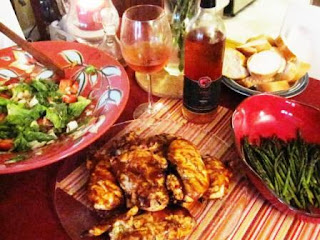By Kitty Maloney
Originally published February 2011

As the cold days of winter march along, the shortest month of the year can seem to be the longest and something hearty, warm and comforting sounds quite appealing. Thumbing through recipes I came across a recipe for Shepherd’s Pie and immediately I knew two things: one, I wanted to substitute buffalo meat and two, I had the perfect wine to pair with this dish, a 2005 Williamsburg Winery Merlot Reserve.
Now the discerning reader will pause and think, “Wait she wrote Shepherd’s Pie but she is not using Lamb, she is using beef… wouldn’t that make it a Cottage Pie?” Technically the distinction between Shepherd’s Pie and Cottage Pie is the principle ingredient used: Shepherd’s P:ie equals lamb (mutton) and Cottage Pie equals beef. However, in the United States the terms and ingredients are often used interchangeably, so it would not be surprising to see Shepherd’s Pie on a menu or recipe where the principle ingredient is beef. I would not be true to my Irish roots if I did not also point out that Cottage Pie is often used in Britain and Shepherd’s Pie is used in Ireland. So for me, this will be Shepherd’s Pie (but feel free to call it want you want).
A few notes about cooking with ground buffalo: Keep in mind that buffalo is very lean and slightly sweet in flavor (think well aged beef). This flavor profile is important to note when you are pairing with wine and adding spices to the recipe. I came across several recipes that added in another lean meat (chicken, turkey or beef with 4% fat.) for texture and for just a little extra fat that holds the dish together ( I added ½ pound of lean ground beef). Alternatively, if you do not want to add another meat into the recipe or if you are grilling (as in buffalo burgers), you may want to lightly (and I mean light) add or coat with a light cooking oil to help prevent over drying of the meat.

The wine had been, like a dollar burning a hole in a pocket, beckoning from the wine rack since it was purchased last August on a visit to the Williamsburg Winery. Why pair it with comfort food? That seed was planted by our host, a knowledgeable gentleman that was our guide for our reserve tasting at the winery, as he poured the Merlot. Normally I would have not favored the merlot; I would have tasted it, made some note and waited for the tasting of the more robust Cabernet Sauvignon, not for any other reason but out of habit. No there is no “Sideways” tantrum out of this wine drinker regarding Merlot; I just gravitate towards a bigger red wine. But something about this Merlot lingered long enough to catch my attention. I asked for another taste and was intrigued.
In 1985, the Williamsburg Winery was founded with the goal of developing wines that reflect the qualities of Virginia and its various micro-climates. It is located in the heart of Williamsburg, not far from the area known as Colonial Williamsburg. In the early 2000’s, after winning many awards for its wines and the arrival of Matthew G.R. Meyer as the winemaker, the Williamsburg Winery endeavored to place its wines on the world stage. This endeavor was met with great success, over the course of the decade their wines have won several international awards.

Merlot, what to say about merlot? There is so much written about it. Merlot is one of the best known varietals in the world and became quite a media darling in late 1991 due to Morely Safer’s report for 60 Minutes entitled “The French Paradox.”Although, the wine referred to in the 60 Minutes segment was red wine, it was Merlot that benefited the most of growing popularity of red wine. Merlot with its soft tannins and subtle flavors are easily approachable for most new to red wine. It was not until 2004 and the independent film “Sideways,” that Merlot hit a rough patch. All it took was a tantrum by the movie’s character Miles when he says to the character Jack, “If anyone orders merlot, I am leaving. I am not drinking any (blank) Merlot!” Following the movie’s release, Merlot sales decreased and almost overnight a negative bias towards the wine took hold. A sad turn of events for Merlot but do not fret for it is still quite popular as it is allegedly the second most popular wine in the United States.

The Pairing: Williamsburg Winery 2005 Virginia Merlot Reserve and a Buffalo Shepherd’s Pie.
In my opinion, Shepherd’s Pie can tend to be on the bland side so I added lots of savory green herbs, cumin, garlic and a few additional interesting twists. The first was adding in a little ground Jamaican allspice. The second twist was that I replaced half of the beef broth (as called for in the recipe), with the Merlot. The last twist was the roasted garlic that was added to the mashed potatoes. Shepherd’s Pie definitely puts a cook’s knife skills to the test with the dicing of the carrots, onions and celery but the finer the dice the best the blending of all the ingredients when the are all incorporated into the baking dish. Such labors, however, are well worth the effort.
At first taste of the Merlot, the wine had good body with soft lush fruit that is classic to the Merlot varietal. There were notes of herbs, cocoa, leather and wood with a finish which was delicate and lingering. The nose of this wine was filled with delightful herbal notes and a touch of vanilla.

When paired with the Shepherd’s Pie, the herbal notes of the wine were brought forward by the earthiness of the pie. The wine’s well-balanced tannins helped keep the mashed potatoes from over powering the wine. The strong texture of the buffalo was a nice match to the merlot’s tannins. The sweetness of the vegetables brought forward the more jammy flavors of the fruit notes found in the merlot. I think one of the keys to this very well-rounded pairing were the herbs in the Shepherd’s Pie, especially the ground Jamaican allspice. Jamaican allspice
suggests a blend of cloves, cinnamon and nutmeg. Those flavors square nicely with chocolate and vanilla nuances found in the wine. Further, since allspice is made from a dried fruit, it also compliments the berry and apple notes of the Merlot.
If you are ones of those that turned his or her back on Merlot in the mid 2000’s, I invite you to give the varietal another try. Pick your favorite comfort food and pour a glass Merlot. I promise that you will marvel at the pairing.
 Yes, I know it has been awhile. I lost track of time.
Yes, I know it has been awhile. I lost track of time.
















































